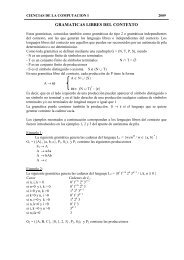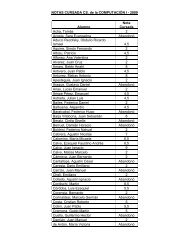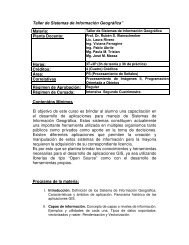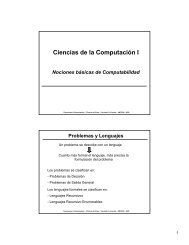Libro de Resúmenes / Book of Abstracts (Español/English)
Libro de Resúmenes / Book of Abstracts (Español/English)
Libro de Resúmenes / Book of Abstracts (Español/English)
You also want an ePaper? Increase the reach of your titles
YUMPU automatically turns print PDFs into web optimized ePapers that Google loves.
Resumenes 172<br />
Análisis <strong>de</strong> un mo<strong>de</strong>lo para la dinámica <strong>de</strong> infecciones virales<br />
Cruz Vargas De-León<br />
Universidad Autónoma <strong>de</strong> Guerrero, Facultad <strong>de</strong> Matemáticas, Av. Lázaro Cár<strong>de</strong>nas,<br />
S/n, Ciudad Universitaria, C.P. 39000, Guerrero, México.<br />
czvdleon@yahoo.com.mx<br />
Los virus son agentes infecciosos, parásitos intracelulares obligados<br />
que requieren <strong>de</strong> una célula huésped. Las partículas virales libres inva<strong>de</strong>n a<br />
las células huésped y las convierten en células infectadas. Y las células<br />
infectadas producen nuevas partículas virales capaces <strong>de</strong> iniciar otros ciclos<br />
<strong>de</strong> infección.<br />
En este trabajo se <strong>de</strong>scribe la dinámica <strong>de</strong> infecciones virales a través<br />
<strong>de</strong> un mo<strong>de</strong>lo matemático basado en ecuaciones diferenciales ordinarias<br />
que involucra tres variables: población <strong>de</strong> células huésped (células<br />
susceptibles al virus), C(t); células infectadas, I(t); y partículas virales<br />
libres, V(t). El termino <strong>de</strong> infección viral es <strong>de</strong> la forma bilineal <strong>de</strong> la ley <strong>de</strong><br />
“acción <strong>de</strong> masas”.<br />
Se muestra que el análisis <strong>de</strong> estabilidad local esta completamente<br />
<strong>de</strong>terminado por el número reproductivo básico, R0. Si R01, entonces E0 es inestable y existe un estado <strong>de</strong> equilibrio<br />
endémico-infectado, E1 es local asintóticamente estable, en este caso la<br />
infección viral se convierte en persistente.<br />
El segundo método <strong>de</strong> Lyapunov provee la estabilidad global <strong>de</strong> los<br />
estados <strong>de</strong> equilibrio E0 (para R0≤1) y E1 (para R0>1).<br />
Se realizan simulaciones numéricas con el paquete Maple, versión 9.<br />
Los parámetros requeridos para las simulaciones se <strong>de</strong>ducen <strong>de</strong> la<br />
literatura.<br />
Palabras claves: Dinámica Viral, Número reproductivo básico, Estabilidad<br />
Local, Función Lyapunov, Simulaciones numéricas<br />
Analysis <strong>of</strong> a mo<strong>de</strong>l for the dynamics <strong>of</strong> viral infections<br />
Viruses are infectious particles, obligate intracellular parasites that<br />
require a host cell. Virus particles inva<strong>de</strong> host cells and transform them into<br />
infected cells. Infected cells produce new virus particles.<br />
In this paper we <strong>de</strong>scribed the dynamics <strong>of</strong> viral infections a through<br />
<strong>of</strong> mathematical mo<strong>de</strong>l based on ordinary differential equation involving<br />
three variables: population sizes <strong>of</strong> uninfected cells (host cells), C(t);<br />
infected cells, I(t); and free virus particles, V(t). The viral infections term is<br />
<strong>of</strong> the bilinear “mass-action” form.<br />
We show that the study <strong>of</strong> local stability is completely <strong>de</strong>termined by<br />
the basic reproductive number, R0. If R01, then E0 is unstable<br />
and there exists an unique en<strong>de</strong>mic equilibrium, E1 is locally asymptotically<br />
stable, in this case the viral infections becomes in persistent.



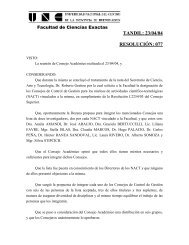
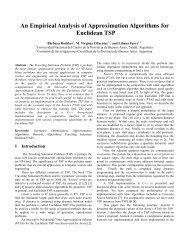
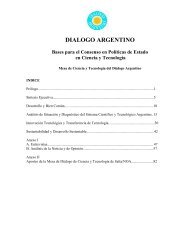


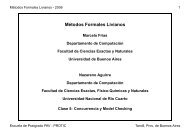
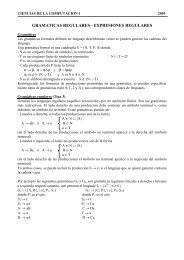

![Clase 13 [pdf]](https://img.yumpu.com/19616969/1/190x245/clase-13-pdf.jpg?quality=85)

